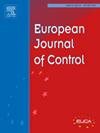非线性切换系统滑模控制设计的不变性方法
IF 2.6
3区 计算机科学
Q2 AUTOMATION & CONTROL SYSTEMS
引用次数: 0
摘要
本文提出了一种在单输入单输出切换非线性系统中合成滑模控制器的方法。该方法称为不变性控制法,利用与滑动面坐标函数的每个常数水平集相关联的不变性条件。将SM控制方案分解为两个部分:平滑不变反馈控制器和Delta-Sigma调制器。平滑不变性反馈控制器代表特定情况下的等效控制,而Delta-Sigma调制器根据不变性控制器的输出向切换装置提供所需的二值输入信号。该方法可以应用于具有切换输入的差分平面系统,使用线性、自补偿滑动面坐标函数。该方法与平均系统的自抗扰控制方案一致,但加入了一个Delta-Sigma调制器。本文通过数字计算机仿真和实验室实验,结合一些重要的应用实例,说明了该方法的有效性。本文章由计算机程序翻译,如有差异,请以英文原文为准。
An invariance approach for sliding mode control design in nonlinear switched systems
This article presents a method for synthesizing sliding mode controllers in Single Input Single Output (SISO) switched nonlinear systems. The method, called the invariance control method, utilizes the invariance condition associated with each constant level set of the sliding surface coordinate function. It decomposes the SM control scheme into two parts: a smooth invariance feedback controller and a Delta-Sigma modulator. The smooth invariance feedback controller represents the equivalent control in a specific case, while the Delta-Sigma modulator provides the required binary-valued input signal to the switched plant based on the output of the invariance controller. The method can be applied to differentially flat systems with switched inputs, using linear, self-compensating sliding surface coordinate functions. The approach aligns with the Active Disturbance Rejection Control scheme for the average system but incorporates a Delta-Sigma modulator. The article showcases the method’s effectiveness through digital computer simulations and laboratory experiments with non-trivial application examples.
求助全文
通过发布文献求助,成功后即可免费获取论文全文。
去求助
来源期刊

European Journal of Control
工程技术-自动化与控制系统
CiteScore
5.80
自引率
5.90%
发文量
131
审稿时长
1 months
期刊介绍:
The European Control Association (EUCA) has among its objectives to promote the development of the discipline. Apart from the European Control Conferences, the European Journal of Control is the Association''s main channel for the dissemination of important contributions in the field.
The aim of the Journal is to publish high quality papers on the theory and practice of control and systems engineering.
The scope of the Journal will be wide and cover all aspects of the discipline including methodologies, techniques and applications.
Research in control and systems engineering is necessary to develop new concepts and tools which enhance our understanding and improve our ability to design and implement high performance control systems. Submitted papers should stress the practical motivations and relevance of their results.
The design and implementation of a successful control system requires the use of a range of techniques:
Modelling
Robustness Analysis
Identification
Optimization
Control Law Design
Numerical analysis
Fault Detection, and so on.
 求助内容:
求助内容: 应助结果提醒方式:
应助结果提醒方式:


